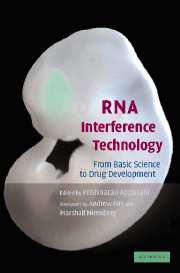Book contents
- Frontmatter
- Contents
- Foreword by Andrew Fire
- Foreword by Marshall Nirenberg
- List of Contributors
- Introduction
- Section one Basic RNAi, siRNA, microRNAs and gene-silencing mechanisms
- Section two Design, synthesis of siRNAs
- Section three Vector development and in vivo, in vitro and in ovo delivery methods
- Section four Gene silencing in model organisms
- Section five Drug target validation
- Section six Therapeutic and drug development
- 26 RNAi-mediated silencing of viral gene expression and replication
- 27 RNAi in drug development: Practical considerations
- 28 RNA interference studies in liver failure
- 29 RNAi applications in living animal systems
- Section seven High-throughput genome-wide RNAi analysis
- Index
- Plate section
- References
29 - RNAi applications in living animal systems
Published online by Cambridge University Press: 31 July 2009
- Frontmatter
- Contents
- Foreword by Andrew Fire
- Foreword by Marshall Nirenberg
- List of Contributors
- Introduction
- Section one Basic RNAi, siRNA, microRNAs and gene-silencing mechanisms
- Section two Design, synthesis of siRNAs
- Section three Vector development and in vivo, in vitro and in ovo delivery methods
- Section four Gene silencing in model organisms
- Section five Drug target validation
- Section six Therapeutic and drug development
- 26 RNAi-mediated silencing of viral gene expression and replication
- 27 RNAi in drug development: Practical considerations
- 28 RNA interference studies in liver failure
- 29 RNAi applications in living animal systems
- Section seven High-throughput genome-wide RNAi analysis
- Index
- Plate section
- References
Summary
Introduction
RNA interference, or RNAi, refers to a conserved post-transcriptional gene silencing mechanism in which a small antisense RNA serves as the sequence specific effector molecule. In plants, Caenorhabditis elegans and Drosophila, where the mechanism was originally elucidated (Bernstein et al., 2001), this effector is derived from a long, double-stranded RNA (dsRNA) trigger, which is processed by the cellular enzyme Dicer into 21–23 nucleotide dsRNAs referred to as short interfering RNAs (siRNAs). The anti-sense strand of the siRNA becomes incorporated into the multi-protein RNA-induced silencing complex (RISC); there, it serves as a guide for cleavage of the mRNA within the target site, when the anti-sense strand is completely complementary to the target.
The RNAi pathway was also shown to occur in mammalian cells subsequent to the discovery of RNAi in lower eukaryotes (Caplen et al., 2001; Elbashir et al., 2001); however, since dsRNA longer than 30 nucleotides triggers the interferon pathway in most mammalian cells, long dsRNA cannot be used to induce RNAi. This difficulty can be overcome by using exogenously introduced or transcribed siRNAs to bypass the Dicer step and directly activate homologous mRNA degradation without initiating the interferon response in most cases. The siRNAs may be in the form of two separate strands, mimicking the natural Dicer product; or may consist of a single hairpin molecule (shRNA) where the sense and anti-sense strands are linked by a short loop.
Information
- Type
- Chapter
- Information
- RNA Interference TechnologyFrom Basic Science to Drug Development, pp. 406 - 416Publisher: Cambridge University PressPrint publication year: 2005
